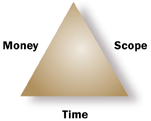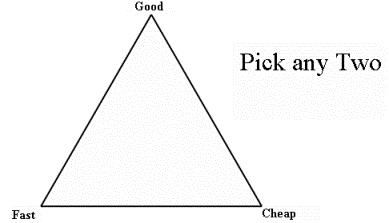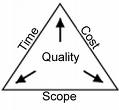
The Project Management Triangle
Project Communication Management
Phases and Methods of Project Management
Tthe project triangle is interrelationship of time, money, and scope.
If you adjust any one of these elements, the other two are affected. For example, if you adjust the project plan to shorten the schedule, you might increase costs and decrease scope.

Project management gets most interesting when you have to balance the time, cost, and scope constraints of your projects—"balance" as on a high wire.
Scope, Time and Cost, are the three essential elements of any project. To succeed as a project manager, you'll have to know quite a bit about how all three of these constraints apply to your projects. You need a tool to help manage them. If you adjust any one side of the triangle, the other two sides are affected.
As you adjust resources, your schedule changes. For example, if you have a number of resource overallocations (overallocation: The result of assigning more tasks to a resource than the resource can accomplish in the working time available.) and you level (leveling: Resolving resource conflicts or overallocations by delaying or splitting certain task) the schedule might now include split tasks and delays that extend the finish date.
 but
you cannot have the three togrether!
but
you cannot have the three togrether!
In Project Execution and control phase of project management we can adopt a more complex matrix of balance that includes the element of quality: CSSQ is the acronym for a projectís linked quadruple constraints Cost, Scope, Schedule, and Quality.

See The 9 topic areas of project management knowledge :
External links:
See http://en.wikipedia.org/wiki/Project_triangle; http://office.microsoft.com/en-us/project/HA010211801033.aspx